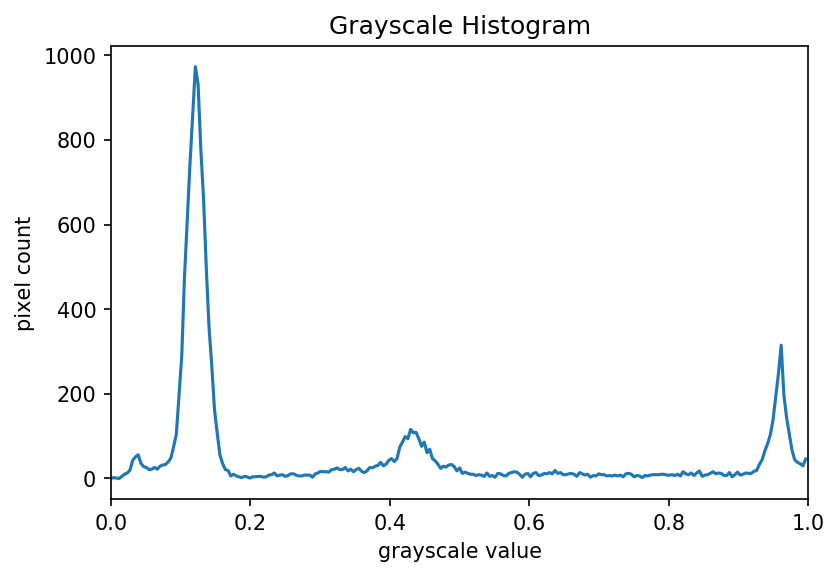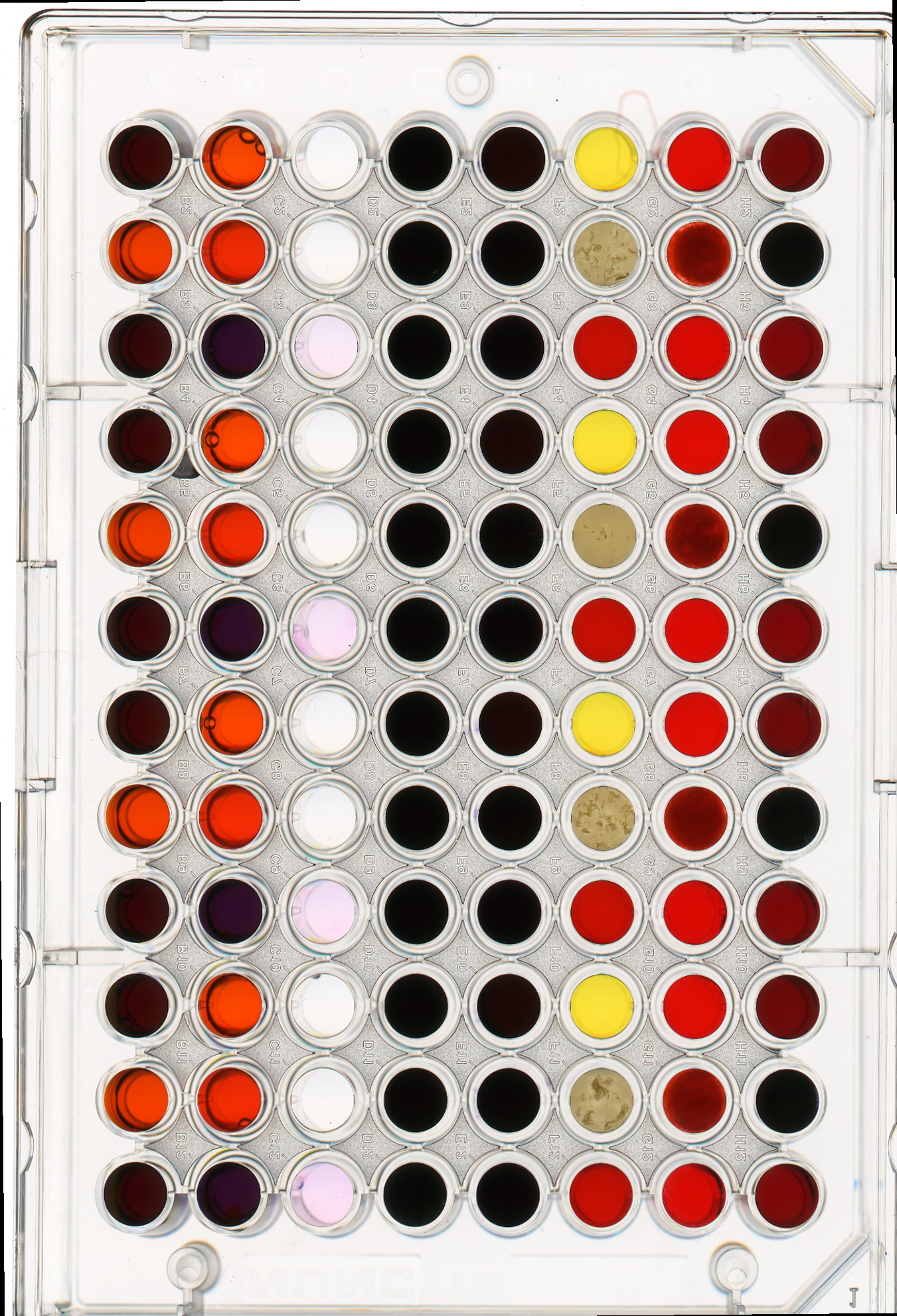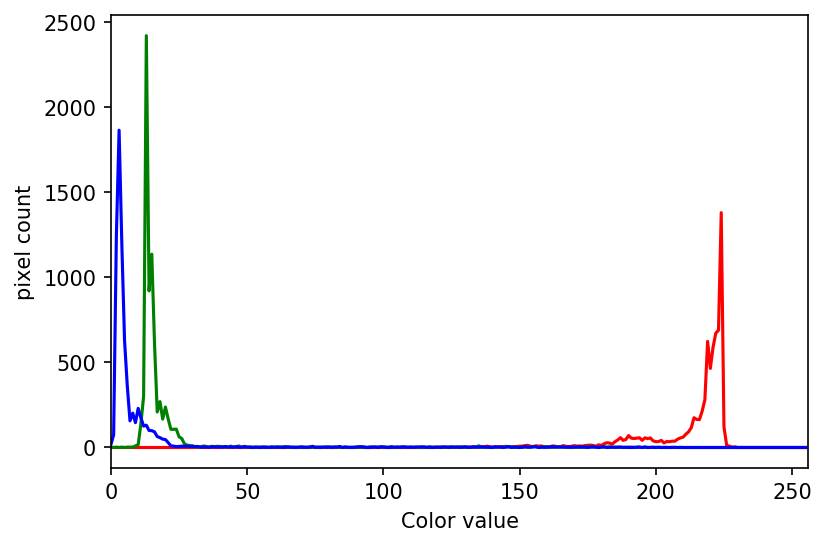Creating Histograms
Overview
Teaching: 25 min
Exercises: 60 minQuestions
How can we create grayscale and color histograms to understand the distribution of color values in an image?
Objectives
Explain what a histogram is.
Load an image in grayscale format.
Create and display grayscale and color histograms for entire images.
Create and display grayscale and color histograms for certain areas of images, via masks.
In this episode, we will learn how to use skimage functions to create and display histograms for images.
Introduction to Histograms
As it pertains to images, a histogram is a graphical representation showing how frequently various color values occur in the image. We saw in the Image Basics episode that we could use a histogram to visualize the differences in uncompressed and compressed image formats. If your project involves detecting color changes between images, histograms will prove to be very useful, and histograms are also quite handy as a preparatory step before performing Thresholding or Edge Detection.
Grayscale Histograms
We will start with grayscale images and histograms first, and then move on to color images. Here is a Python script to load an image in grayscale instead of full color, and then create and display the corresponding histogram. The first few lines are:
"""
* Generate a grayscale histogram for an image.
*
* Usage: python GrayscaleHistogram.py <fiilename>
"""
import sys
import numpy as np
import skimage.color
import skimage.io
import skimage.viewer
from matplotlib import pyplot as plt
# read image, based on command line filename argument;
# read the image as grayscale from the outset
image = skimage.io.imread(fname=sys.argv[1], as_gray=True)
# display the image
viewer = skimage.viewer.ImageViewer(image)
viewer.show()
In the program, we have a new import from matplotlib, to gain access to the
tools we will use to draw the histogram. The statement
from matplotlib import pyplot as plt
loads up the pyplot library, and gives it a shorter name, plt.
Next, we use the skimage.io.imread() function to load our image. We use the first
command line parameter as the filename of the image, as we did in the
Skimage Images lesson. The second parameter
to skimage.io.imread() instructs the function to transform the image into
grayscale with a value range from 0 to 1 while loading the image.
We will keep working with images in the value range 0 to 1 in this lesson.
Remember that we can transform an image back to the range 0 to 255 with
the function skimage.util.img_as_ubyte.
Skimage does not provide a special function to compute histograms, but we can use
the function np.histogram instead:
# create the histogram
histogram, bin_edges = np.histogram(image, bins=256, range=(0, 1))
The parameter bins determines the histogram size, or the number of “bins” to use for
the histogram. We pass in 256 because we want to see the pixel count for
each of the 256 possible values in the grayscale image.
The parameter range is the range of values each of the pixels in the image can
have. Here, we pass 0 and 1, which is the value range of our input image after transforming it
to grayscale.
The first output of the np.histogram function is a one-dimensional NumPy array,
with 256 rows and one column, representing the number of pixels with the color
value corresponding to the index. I.e., the first number in the array is the
number of pixels found with color value 0, and the final
number in the array is the number of pixels found with color value 255.
The second output of np.histogram is an array with the bin edges and one column and 257 rows (one more than the histogram itself).
There are no gaps between the bins, which means that the end of the first bin, is the start of the second and so on.
For the last bin, the array also has to contain the stop, so it has one more element, than the histogram.
Next, we turn our attention to displaying the histogram, by taking advantage
of the plotting facilities of the matplotlib library.
# configure and draw the histogram figure
plt.figure()
plt.title("Grayscale Histogram")
plt.xlabel("grayscale value")
plt.ylabel("pixels")
plt.xlim([0.0, 1.0]) # <- named arguments do not work here
plt.plot(bin_edges[0:-1], histogram) # <- or here
plt.show()
We create the plot with
plt.figure(), then label the figure and the coordinate axes with
plt.title(), plt.xlabel(), and plt.ylabel() functions. The last step in
the preparation of the figure is to set the limits on the values on the
x-axis with the plt.xlim([0.0, 1.0]) function call.
Variable-length argument lists
Note that we cannot used named parameters for the
plt.xlim()orplt.plot()functions. This is because these functions are defined to take an arbitrary number of unnamed arguments. The designers wrote the functions this way because they are very versatile, and creating named parameters for all of the possible ways to use them would be complicated.
Finally, we create the histogram plot itself with plt.plot(bin_edges[0:-1], histogram).
We use the left bin edges as x-positions for the histogram values by indexing the bin_edges array to ignore the last value (the right edge of the last bin).
Then we make it appear with plt.show(). When we run the program on this image of a plant seedling,
Histograms in matplotlib
Matplotlib provides a dedicated function to compute and display histograms:
plt.hist(). We will not use it in this lesson in order to understand how to calculate histograms in more detail. In practice, it is a good idea to use this function, because it visualizes histograms more appropriately thanplt.plot(). Here, you could use it by callingplt.hist(image.flatten(), bins=256, range=(0, 1))instead ofnp.histogram()andplt.plot()(*.flatten()is a numpy function that converts our two-dimensional image into a one-dimensional array).

the program produces this histogram:
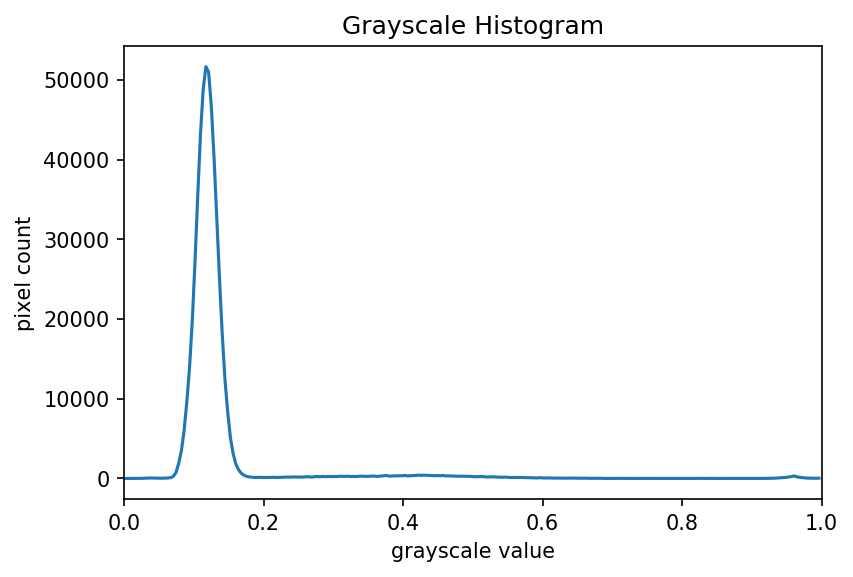
Using a mask for a histogram (25 min)
Looking at the histogram above, you will notice that there is a large number of very dark pixels, as indicated in the chart by the spike around the grayscale value 0.12. That is not so surprising, since the original image is mostly black background. What if we want to focus more closely on the leaf of the seedling? That is where a mask enters the picture!
Navigate to the Desktop/workshops/image-processing/05-creating-histograms directory, and edit the GrayscaleMaskHistogram.py program. The skeleton program is a copy of the mask program above, with comments showing where to make changes.
First, use a tool like ImageJ to determine the (x, y) coordinates of a bounding box around the leaf of the seedling. Then, using techniques from the Drawing and Bitwise Operations episode, create a mask with a white rectangle covering that bounding box.
After you have created the mask, apply it to the input image before passing it to the
np.histogramfunction. Then, run the GrayscaleMaskHistogram.py program and observe the resulting histogram.Solution
""" * Generate a grayscale histogram for an image. * * Usage: python GrayscaleMaskHistogram.py <filename> """ import sys import numpy as np import skimage.draw import skimage.io import skimage.viewer from matplotlib import pyplot as plt # read image, based on command line filename argument; # read the image as grayscale from the outset img = skimage.io.imread(fname=sys.argv[1], as_gray=True) # display the image viewer = skimage.viewer.ImageViewer(img) viewer.show() # create mask here, using np.zeros() and skimage.draw.rectangle() mask = np.zeros(shape=img.shape, dtype="bool") rr, cc = skimage.draw.rectangle(start=(199, 410), end=(384, 485)) mask[rr, cc] = True # mask the image and create the new histogram histogram, bin_edges = np.histogram(img[mask], bins=256, range=(0.0, 1.0)) # configure and draw the histogram figure plt.figure() plt.title("Grayscale Histogram") plt.xlabel("grayscale value") plt.ylabel("pixel count") plt.xlim([0.0, 1.0]) plt.plot(bin_edges[0:-1], histogram) plt.show()Your histogram of the masked area should look something like this:
Color Histograms
We can also create histograms for full color images, in addition to grayscale histograms. We have seen color histograms before, in the Image Basics episode. A program to create color histograms starts in a familiar way:
"""
* Python program to create a color histogram.
*
* Usage: python ColorHistogram.py <filename>
"""
import sys
import skimage.io
import skimage.viewer
from matplotlib import pyplot as plt
# read original image, in full color, based on command
# line argument
image = skimage.io.imread(fname=sys.argv[1])
# display the image
viewer = skimage.viewer.Viewer(image)
viewer.show()
We import the needed libraries, read the image based on the command-line parameter (in color this time), and then display the image.
Next, we create the histogram, by calling the np.histogram function three
times, once for each of the channels. We obtain the individual channels, by
slicing the image along the last axis. For example, we can obtain the red color channel
by calling r_chan = image[:, :, 0].
# tuple to select colors of each channel line
colors = ("r", "g", "b")
channel_ids = (0, 1, 2)
# create the histogram plot, with three lines, one for
# each color
plt.xlim([0, 256])
for channel_id, c in zip(channel_ids, colors):
histogram, bin_edges = np.histogram(
image[:, :, channel_id], bins=256, range=(0, 256)
)
plt.plot(bin_edges[0:-1], histogram, color=c)
plt.xlabel("Color value")
plt.ylabel("Pixels")
plt.show()
We will draw the histogram line for each channel in a different color, and so we create a tuple of the colors to use for the three lines with the
colors = ("r", "g", "b")
line of code. Then, we limit the range of the x-axis with the plt.xlim()
function call.
Next, we use the for control structure to iterate through the three
channels, plotting an appropriately-colored histogram line for each. This may
be new Python syntax for you, so we will take a moment to discuss what is
happening in the for statement.
The Python built-in zip() function takes a series of one or more lists and
returns an iterator of tuples, where the first tuple contains the first
element of each of the lists, the second contains the second element of each
of the lists, and so on.
Iterators, tuples, and
zip()In Python, an iterator, or an iterable object, is, basically, something that can be iterated over with the
forcontrol structure. A tuple is a sequence of objects, just like a list. However, a tuple cannot be changed, and a tuple is indicated by parentheses instead of square brackets. Thezip()function takes one or more iterable objects, and returns an iterator of tuples consisting of the corresponding ordinal objects from each parameter.For example, consider this small Python program:
list1 = (1, 2, 3, 4, 5) list2 = ("a", "b", "c", "d", "e") for x in zip(list1, list2): print(x)Executing this program would produce the following output:
(1, ‘a’)
(2, ‘b’)
(3, ‘c’)
(4, ‘d’)
(5, ‘e’)
In our color histogram program, we are using a tuple, (channel_id, c), as the
for variable. The first time through the loop, the channel_id variable takes the
value 0, referring to the position of the red color channel,
and the c variable contains the string "r". The second time
through the loop the values are the green channels position and "g", and the third
time they are the blue channel position and "b".
Inside the for loop, our code looks much like it did for the grayscale
example. We calculate the histogram for the current channel with the
histogram, bin_edges = np.histogram(image[:, :, channel_id], bins=256, range=(0, 256))
function call, and then add a histogram line of the correct color to the plot with the
plt.plot(bin_edges[0:-1], histogram, color=c)
function call. Note the use of our loop variables, channel_id and c.
Finally we label our axes and display the histogram, shown here:
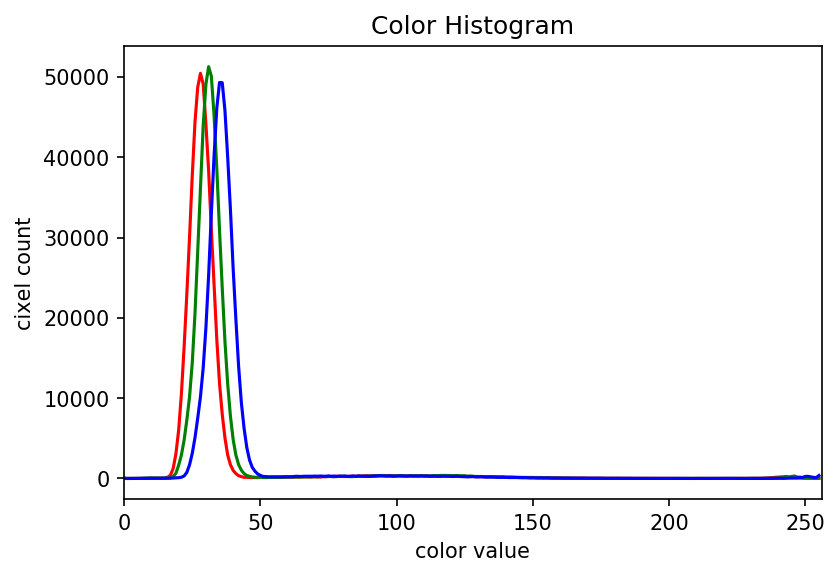
Color histogram with a mask (25 min)
We can also apply a mask to the images we apply the color histogram process to, in the same way we did for grayscale histograms. Consider this image of a well plate, where various chemical sensors have been applied to water and various concentrations of hydrochloric acid and sodium hydroxide:
Suppose we are interested in the color histogram of one of the sensors in the well plate image, specifically, the seventh well from the left in the topmost row, which shows Erythrosin B reacting with water.
Use ImageJ to find the center of that well and the radius (in pixels) of the well. Then, navigate to the Desktop/workshops/image-processing/05-creating-histograms directory, and edit the ColorHistogramMask.py program.
Guided by the comments in the ColorHistogramMask.py program, create a circular mask to select only the desired well. Then, use that mask to apply the color histogram operation to that well. When you execute the program on the plate-01.tif image, your program should display
maskedImg, which will look like this:
And, the program should produce a color histogram that looks like this:
Solution
Here is the modified version of ColorHistogramMask.py that produced the preceding images.
""" * Python program to create a color histogram on a masked image. * * Usage: python ColorHistogramMask.py <filename> """ import sys import skimage.io import skimage.viewer import skimage.draw import numpy as np from matplotlib import pyplot as plt # read original image, in full color, based on command # line argument image = skimage.io.imread(fname=sys.argv[1]) # display the original image viewer = skimage.viewer.ImageViewer(image) viewer.show() # create a circular mask to select the 7th well in the first row # WRITE YOUR CODE HERE mask = np.zeros(shape=image.shape[0:2], dtype="bool") circle = skimage.draw.circle(240, 1053, radius=49, shape=image.shape[:2]) mask[circle] = 1 # just for display: # make a copy of the image, call it masked_image, and # use np.logical_not() and indexing to apply the mask to it # WRITE YOUR CODE HERE masked_img = image[:] masked_img[np.logical_not(mask)] = 0 # create a new window and display maskedImg, to verify the # validity of your mask # WRITE YOUR CODE HERE viewer = skimage.viewer.ImageViewer(masked_img) viewer.show() # list to select colors of each channel line colors = ("r", "g", "b") channel_ids = (0, 1, 2) # create the histogram plot, with three lines, one for # each color plt.xlim([0, 256]) for (channel_id, c) in zip(channel_ids, colors): # change this to use your circular mask to apply the histogram # operation to the 7th well of the first row # MODIFY CODE HERE histogram, bin_edges = np.histogram( image[:, :, channel_id][mask], bins=256, range=(0, 256) ) plt.plot(histogram, color=c) plt.xlabel("color value") plt.ylabel("pixel count") plt.show()
Histograms for the morphometrics challenge (10 min)
Using the grayscale and color histogram programs we developed in this episode, create histograms for the bacteria colonies in the Desktop/workshops/image-processing/10-challenges directory. Save the histograms for later use.
Key Points
We can load images in grayscale by passing the
as_gray=Trueparameter to theskimage.io.imread()function.We can create histograms of images with the
np.histogramfunction.We can separate the RGB channels of an image using slicing operations.
We can display histograms using the
matplotlib pyplotfigure(),title(),xlabel(),ylabel(),xlim(),plot(), andshow()functions.
